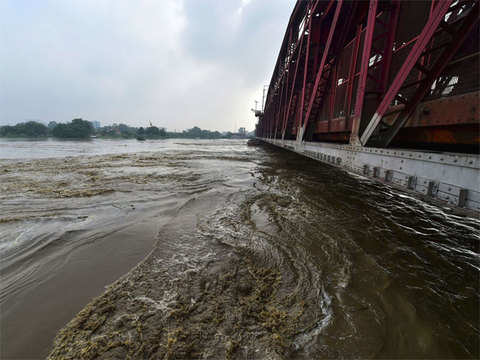
Delhi flood alert: Prepared for any eventuality, says CM Kejriwal as Yamuna level nears danger mark
Atishi, the Public Works Department minister of Delhi, has expressed concerns about the Yamuna River in Delhi approaching the danger mark. The river’s water level is rising due to a significant discharge of water in its upper reaches, which is attributed to heavy rainfall in north Indian states.
The announcement by Atishi highlights the potential risks and challenges posed by the rapid influx of water into the Yamuna River. When a river reaches or exceeds its danger mark, it indicates an increased risk of flooding in nearby areas and necessitates heightened vigilance and precautionary measures to ensure public safety.

Heavy rainfall in the catchment areas of the river, coupled with water being released from upstream reservoirs, can lead to a rapid rise in water levels. This situation requires close monitoring and proactive measures by authorities to mitigate the impact of potential flooding and minimize the risk to residents living in vulnerable areas along the riverbanks.
During such circumstances, local authorities, including the Public Works Department and other relevant agencies, typically implement measures to manage the situation. These measures can include monitoring water levels, issuing alerts and advisories to residents, and deploying resources for flood control and relief efforts.
Given the concerns expressed by Atishi regarding the Yamuna River’s water level, residents and authorities need to remain vigilant and stay updated on the latest information and instructions from relevant sources. Taking necessary precautions and adhering to safety guidelines during periods of increased water levels can help mitigate potential risks and ensure the well-being of the affected communities.

According to Atishi, as of Sunday morning, around 43,000 cusecs (cubic feet per second) of water were being discharged into the Yamuna River from Haryana. However, this discharge has significantly increased to nearly three lakh cusecs. As a result of this substantial influx of water, she predicted that the water level in the Yamuna River would reach the danger mark by around 10-11 am on Tuesday.
The sharp increase in the discharge of water into the Yamuna River indicates the severity of the situation and the potential for rapid water level rise. Such a significant increase in water volume can pose a serious risk of flooding in low-lying areas along the riverbanks.
Atishi’s prediction regarding the water level reaching the danger mark by a specific timeframe provides a sense of urgency for preparedness and response efforts. It underscores the need for residents, authorities, and relevant agencies to remain vigilant and take necessary precautions to ensure public safety.
During periods of rising water levels, it is crucial for authorities to closely monitor the situation, communicate timely updates and advisories to residents, and implement appropriate measures to manage and mitigate the potential impact of flooding. This can include evacuations, setting up temporary shelters, deploying rescue and relief teams, and organizing community awareness programs.

Residents living in areas prone to flooding should also stay informed about the situation, follow safety guidelines, and cooperate with local authorities instructions. Taking necessary precautions and being prepared can help minimize the risks associated with rising water levels and ensure the well-being of the affected communities.
Delhi Chief Minister Arvind Kejriwal has taken proactive steps in response to the relentless downpour and the potential challenges it presents to the city. To address the situation and formulate suitable strategies, he called for a meeting at the Secretariat.
The meeting, attended by Saurabh Bharadwaj, Atishi, and other officials, aimed to bring together key stakeholders and decision-makers to discuss the current scenario and devise appropriate strategies. By convening this meeting, the Chief Minister demonstrated a proactive approach in managing the potential impact of heavy rainfall on the city and its residents.
During the meeting, officials likely discussed various aspects related to flood management, waterlogging, traffic management, and ensuring the safety and well-being of the citizens. The focus was likely on assessing the situation, identifying vulnerable areas, and formulating action plans to address the challenges posed by the heavy rainfall.
Such meetings provide a platform for collaboration, coordination, and effective decision-making among officials and stakeholders. By working together and sharing insights, the aim is to ensure efficient responses, minimize disruptions, and safeguard the interests of the public during such challenging weather conditions.
The efforts made by Chief Minister Arvind Kejriwal and the participation of officials and representatives in this meeting reflect the commitment of the government to effectively manage and mitigate the impact of heavy rainfall in the city. The exchange of ideas and the formulation of strategies during the meeting can contribute to a coordinated and effective response to the challenges posed by the relentless downpour in Delhi.
Chief Minister Arvind Kejriwal acknowledged that the recent rainfall in Delhi exceeded the average levels experienced by the city. He mentioned that while Delhi typically receives rainfall between 100-125mm, this time, the city witnessed 153mm of rainfall on July 8 and 9. Kejriwal emphasized that the existing infrastructure in Delhi was not designed to handle such unprecedented rainfall, which has resulted in difficulties for the city’s residents.
Considering the potential risks associated with the rising water levels, Kejriwal stated that approximately 41,000 people would need to be evacuated if the Yamuna River crosses the danger mark, reaching a water level of 206 meters. This statement highlights the need for preparedness and proactive measures to ensure the safety and well-being of the affected population.
Evacuations are an important aspect of disaster management to safeguard individuals from potential flooding and related hazards. By making this estimation, Kejriwal and the authorities can assess the scale of potential evacuations and plan and allocate resources accordingly.
The acknowledgement by the Chief Minister regarding the limitations of existing infrastructure and the potential risks posed by the rising water levels reflects a realistic understanding of the situation. It underscores the need for coordinated efforts between the government, authorities, and residents to ensure preparedness, response, and timely evacuation if necessary.
During such challenging circumstances, it is crucial for the authorities to continuously monitor the situation, provide regular updates to the public, and ensure effective communication to minimize the risks and consequences of heavy rainfall and potential flooding.
Taking appropriate measures, including evacuation plans, can help mitigate the impact and ensure the safety and well-being of the residents of Delhi.Chief Minister Arvind Kejriwal, addressing the media, assured that all necessary teams were prepared for the evacuation process in response to the rising water levels. He stated that relief camps had been set up to accommodate those who may need to be evacuated.
To tackle the situation, the Public Works Department (PWD) has mobilized a significant number of pumps. Currently, 680 pumps are working to clear the standing water in affected areas. In addition, 326 temporary pumps have been installed to enhance the water drainage process, and 100 mobile pumps are available for immediate deployment if required.
The deployment of a large number of pumps demonstrates the government’s proactive approach in addressing the challenges posed by the heavy rainfall and waterlogging. By utilizing a combination of permanent and temporary pumps, the authorities aim to mitigate the impact of water accumulation and facilitate the drainage process.
In addition to the pumping operations, the government has also taken preventive measures to address road safety. Temporary filling of potholes is being carried out to prevent accidents and ensure smoother movement of vehicles during this period of heavy rainfall.
These measures reflect the concerted efforts of the government and the Public Works Department to manage the situation effectively. By providing relief camps, mobilizing pumps, and addressing road safety concerns, the authorities are taking steps to minimize the inconvenience caused to the public and ensure their safety and well-being.
Continuous monitoring, timely communication, and the availability of necessary resources are crucial during such situations. The government’s preparedness and actions to tackle the challenges posed by heavy rainfall demonstrate their commitment to addressing the immediate needs of the residents and managing the impact of the ongoing downpour.
Chief Minister Arvind Kejriwal emphasized that the government is closely monitoring the situation and would issue orders for regional or city-wide school closures if deemed necessary. This proactive approach aims to ensure the safety of students and minimize potential risks associated with the heavy rainfall and potential flooding.
Kejriwal also highlighted that the possibility of a flood-like situation in Delhi is primarily dependent on the water released by Haryana into the Yamuna River from Hathnikund, rather than the rainfall within Delhi itself. He referred to historical data, specifically mentioning the flood that occurred in Delhi in 1978 when 7 lakh cusecs of water were released from Hathnikund. However, he noted that since then, dams have been constructed along the Yamuna River, and measures have been implemented to manage such situations.
The reference to historical data indicates that the government is drawing upon past experiences and lessons learned to better prepare for and manage the current situation. The construction of dams and other water management measures along the Yamuna River reflects efforts to mitigate the impact of excessive water release and control potential flooding.
By emphasizing the factors influencing the flood-like situation and the measures taken to manage it, Kejriwal seeks to provide reassurance to the public. This information is crucial for public awareness and understanding, as it helps to contextualize the potential risks and the government’s preparedness to address them.
Continuous monitoring of water release, coordination with Haryana, and the implementation of appropriate measures demonstrate the government’s commitment to mitigating the impact of excessive water flow and safeguarding the city and its residents.
Adopting a proactive approach, closely monitoring the situation, and implementing necessary measures are key components of effective disaster management. By keeping schools informed about potential closures and considering the water release from Haryana, the government aims to prioritize the safety and well-being of the people of Delhi during this challenging period.
The Yamuna River in Delhi has surpassed the warning mark of 204.5 meters as Haryana released additional water into the river from the Hathnikund barrage. Persistent rainfall in the upper catchment areas has contributed to this rise in water levels. According to a flood bulletin, the water level at the Old Railway Bridge reached 204.63 meters at 1 pm on Monday. It is projected to further increase to 205.5 meters between 10 am and 12 noon on Tuesday, crossing the danger mark of 205.33 meters.
In light of this situation, Chief Minister Arvind Kejriwal emphasized the importance of collaboration between the governments of all affected states to provide relief to the public. He urged authorities not to engage in finger-pointing during this critical time but rather focus on coordinated efforts to address the challenges arising from the rising water levels.
During times of such crises, it is crucial for all stakeholders to come together, set aside differences, and work collectively to ensure the safety and well-being of the public. Collaboration between states, effective communication, and sharing of resources are vital in managing the situation and minimizing the impact on affected communities.
Kejriwal’s call for collaboration highlights the need for a united approach in managing the situation and providing relief to the public. By avoiding blame games and prioritizing collective efforts, the governments can better coordinate their actions, share resources, and implement necessary measures to address the challenges posed by the rising water levels in the Yamuna River.
The situation calls for swift and coordinated responses, including evacuation plans, setting up relief camps, and ensuring the availability of essential services and supplies. By working together, the authorities can effectively manage the situation and mitigate the potential risks and hardships faced by the affected residents.




